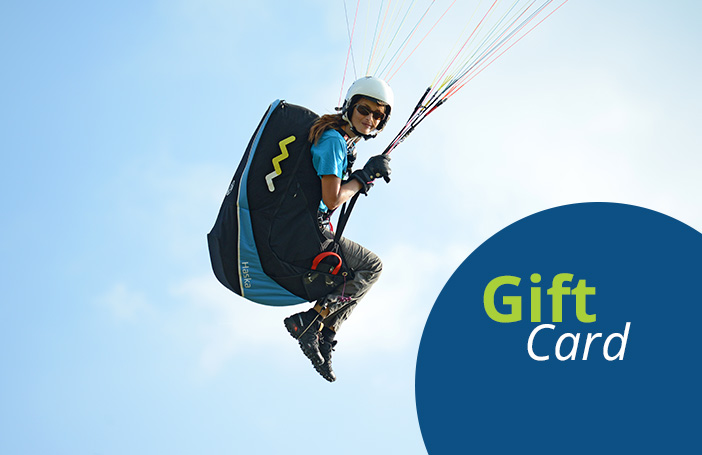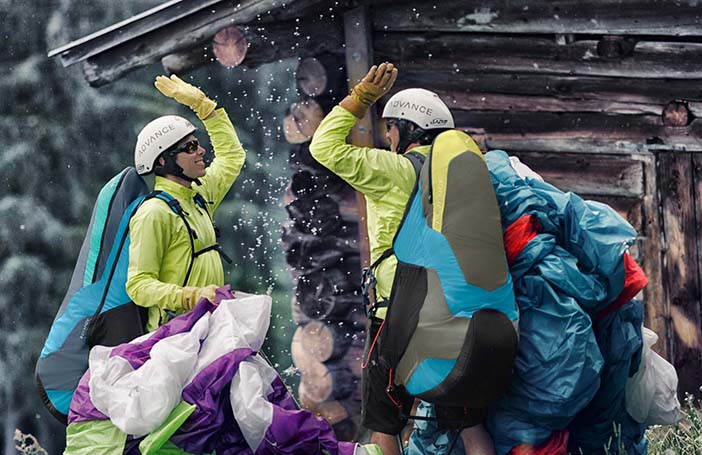
Nova Mentor (PAST MODEL)
Select all options to view stock availability

Nova Mentor
Development and Concept:
NOVA has a long tradition in the class of high level 1-2 wings. The CARBON was the first to set new standards in performance some years ago. Following it, the ARTAX was the new reference in this class. It was not easy for us to realize a step forward with the MAMBOO. Now we wanted to go even further and improve upon the MAMBOO, which successfully held the performance lead in its class until its now, according to the measurements from GLEITSCHIRM MAGAZINE. Reaching this target was very demanding!
It took us one and a half years from the first MENTOR proto (X189: April 24, 2006) to the certification and production start of the final version. Very complex computer simulations (CFD) promised a big step forward in performance for new concepts. But flight tests showed that it was not easy to implement those ideas: Some prototypes impressively demonstrated their performance potential, but they were not good in other disciplines like handling or safety. We didn't just want to build a great performance wing, we also wanted to improve in the disciplines of handling, safety and even more in comfort and simplicity.
Early in Summer 2007 we thought that we had finally reached our goal. We had built wings in S, M and L sizes, which were very promising. But when we did some final performance comparisons against the Mamboo, we had to admit that we had not reached our own performance goals. We had to reject this concept and make further efforts to improve the MENTOR.
Amongst other things, we slightly reduced the aspect ratio and spent a lot of time on improving the wing surfaces. We tried many different wing tip designs and finally found a solution which was quite impressive in terms of performance and handling.
Characteristics:
So the MENTOR ended up with a little less aspect ratio than the MAMBOO, but the performance advantage is remarkable. Also, the handling has improved thanks to the shorter line length and the optimized wing surfaces. Also, the damping in turbulences could be increased. This immediately gives the pilot the impression of increased comfort and safety.
In fact, the MENTOR is less demanding to fly in turbulent air then the MAMBOO. Even if the collapse behavior of the MAMBOO is easy to deal with; it takes quite some effort to fly the wing actively in strong conditions. The MENTOR offers significant more comfort in this matter. But the wing hasn’t lost its agility: If you want the MENTOR to turn immediately, the wing reacts with very little delay. If you want to do steep turns, just add a little more brake, and the wing responds with an efficient and steep turn.
The shorter line length has also a noticeable impact on the take-off behavior. Combined with slightly lighter cloth, the wing rises faster and with less effort above the pilot, without the tendency to overshoot.
As previously mentioned, the performance advantage is clearly noticeable when flying alongside a MAMBOO. Aside from the higher wing efficiency, the thinner lines are the main contributor to this performance step. We used unsheathed, coated DC60 Dyneema lines on the top cascade and also slightly thinner lines on the lower cascades.
We think the MENTOR was worth more than all the effort it took to develop this wing. The MENTOR doesn’t only offer superior performance. With its easy handling and flight behavior, the wing offers this performance to a large group of pilots.
In combination with the easy handling, the MENTOR offers relaxed flying fun for regularly flying pilots at a very high performance level.
Even in strong thermals, the MENTOR has enough handling reserves for tight turns whenever you need them. A little more brake and some weight shift is enough for the MENTOR to react with very little delay and you find yourself in an immediate high-banked turn. We were able to reduce the effect of being pushed out of strong thermals, compared to the MAMBOO. Overall, our test team had lots of fun with this wing, and we are quite sure you will have fun too!
Technical Changes:
The following characteristics have been changed, compared to the MAMBOO, its predecessor:
- Changed the plan form, cut, and a new outer wing. This leads to higher efficiency and better handling.
- Shorter lines enable higher agility, better behaviour in turbulences and improved safety in deep spiral
- Thin, unsheathed and coated Dyneema lines in the upper cascade reduces overall drag.
- Thin risers with a Dyneema inlet reduces the weight of the wing, and leads to slight performance advantages.
- Rework of the cell openings enables a cleaner airflow in this critical area.
- Changed surface tension gives the MENTOR a cleaner finish. Especially in the region of the trailing edge. Furthermore, the distortion in accelerated flight could be reduced.
- Lighter cloth (Porcher 45g/sqm on the top surface, 40g/sqm on the bottom surface) and smaller reinforcements, lead to less weight and to a bigger safety margin.
- Laser-cut profile: The patterns are cut with our new laser cutter, which enables a constant high standard of quality.
- The new brake geometry was a big contributor towards the better handling.
- Slightly changed airfoil shape leads to softer collapses and more stability of the center wing. So the MENTOR has a higher resistance to frontal collapses. Furthermore, the stability in accelerated flight could be improved. The trim and maximum accelerated speeds of the MENTOR are slightly higher than the MAMBOO.
What stayed the same:
- Number of cells
- Sweep
- Separate D-Lines from the top cascade down to the riser
Main Characteristics:
The NOVA MENTOR is a high performance wing in the DHV 1-2 class for regularly flying pilots. Like its predecessors, the wing offers maximum performance with a high level of safety.
Due to its easy and reliable flight behaviour, the MENTOR is suitable for a large group of pilots.
We are convinced that this combination of performance, comfort and safety, has not been seen before in one of our wings.
LTF/EN test reports:
Mentor S, Mentor M, Mentor L, Mentor XXS, Mentor XXS100
Certification videos:
Nova Mentor > Sizes & Weight Ranges
Size |
All-Up Weight Range |
| Nova Mentor XXS | 60-100 kg |
| Nova Mentor XS | 70-90 kg |
| Nova Mentor S | 80-100 kg |
| Nova Mentor M | 95-110 kg |
| Nova Mentor L |
105-130 kg |
Colour Options: Blue Wave; Orange Passion; Red Moon; White Spider
Nova Mentor > Technical Data
Type / Size |
- |
XXS |
XXS100 |
XS |
S |
M |
L |
|
Zoom factor |
- |
0.880 |
0.880 |
0.930 |
0.970 |
1.010 |
1.050 |
|
No of cells |
- |
53 |
53 |
53 |
53 |
53 |
53 |
|
Projected wingspan |
m |
8.61 |
8.61 |
9.06 |
9.48 |
9.89 |
10.28 |
|
Projected surface area |
m² |
18.60 |
18.60 |
20.59 |
22.59 |
24.58 |
26.56 |
|
Projected aspect ratio |
- |
3.98 |
3.98 |
3.98 |
3.98 |
3.98 |
3.98 |
|
Flat wingspan |
m |
10.86 |
10.86 |
11.42 |
11.96 |
12.48 |
12.97 |
|
Flat surface area |
m² |
21.68 |
21.68 |
24.00 |
26.33 |
28.65 |
30.96 |
|
Flat aspect ratio |
- |
5.43 |
5.43 |
5.43 |
5.43 |
5.43 |
5.43 |
|
Line diameter |
mm |
0.6 / 1.2 / 1.4 |
0.6 / 1.2 / 1.4 |
0.6 / 1.2 / 1.4 |
0.6 / 1.2 / 1.4 |
0.6 / 1.2 / 1.4 |
0.6 / 1.2 / 1.4 |
|
Line length |
m |
6.62 |
6.62 |
6.97 |
7.30 |
7.61 |
7.91 |
|
Line consumption |
m |
310 |
310 |
326 |
342 |
356 |
371 |
|
max. profile depth |
m |
2.49 |
2.49 |
2.60 |
2.72 |
2.84 |
2.95 |
|
min. profile depth |
m |
0.62 |
0.62 |
0.65 |
0.68 |
0.71 |
0.74 |
|
Weight |
kg |
5.2 |
5.2 |
5.4 |
5.9 |
6.4 |
6.8 |
|
Legal take-off weight |
kg |
60-80 |
80-100 |
70-90 |
80-100 |
95-110 |
105-130 |
|
take-off weight motor |
kg |
||||||
|
Places |
- |
1 |
1 |
1 |
1 |
1 |
1 |
|
Certification |
- |
LTF 1-2 , EN B |
LTF 2-3 , EN C |
LTF 1-2, EN B |
LTF 1-2, EN B |
LTF 1-2 |
LTF 1-2, EN B |
| Condition | New |
|---|---|
| EN Certification | EN B, EN C |
| LTF Certification | LTF 1-2 |
| Model Status | Past model |
Standard UK delivery - £3.95 / FREE on orders over £100.
Outside the UK - delivery calculated at checkout (based on the total order value and your delivery address).
We use Royal Mail, Parcelforce Worldwide and other courier companies (e.g. DHL, DPD) depending on shipment value, weight, destination etc.
For more information, please view our order and delivery FAQs page.
If you are not 100% satisfied with your order, you have 14 days from the day of delivery to request a refund.
Delivery costs will not be refunded and you will be responsible for the delivery cost to return the order.
For more information, please read our returns and exchanges policy.



